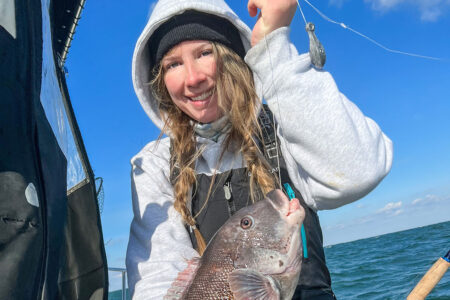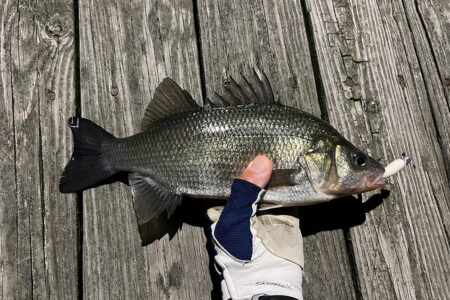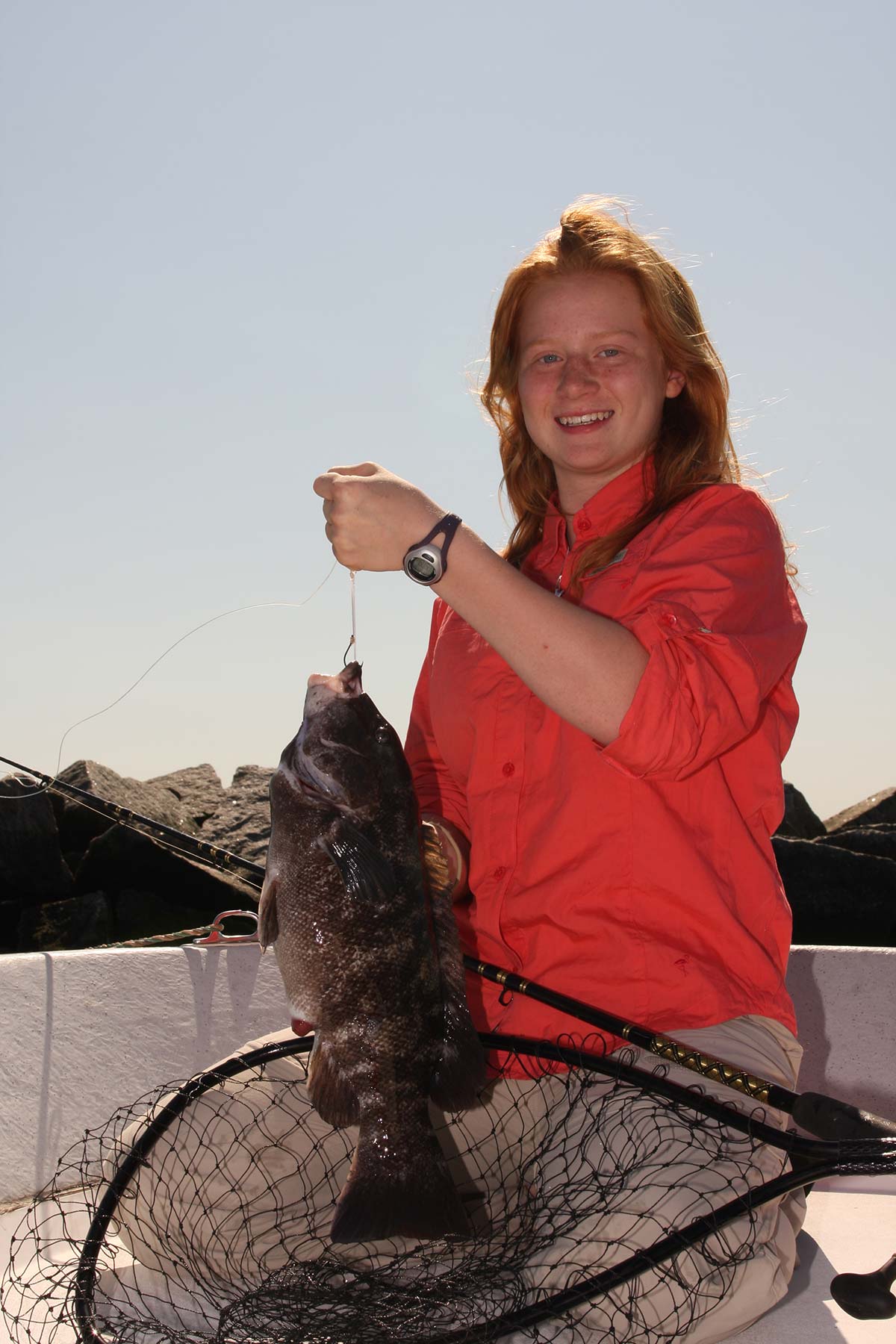
Target skinny water for a limit of October blackfish.
During mid-October last year, a brisk high-pressure system had swept down from Canada triggering two days of small craft advisories for northwest winds gusting over 25 knots. It’s a rare occasion when I don’t need to worry about dealing with winds greater than 15 knots, and this was one of them. The wind direction was offshore for Niantic Bay, and like many other tog enthusiasts out there that day, I ran along the shoreline in calm conditions to one of my favorite blackfish humps with fishing buddy Vince Battista.
After circling a ledge several times, finding its peak, and calculating the wind direction and current strength, I nudged the throttle into reverse and motioned to Vince to drop anchor. Snugging the rode on the cleat just as we reached the high point was key, and we missed it the first time. We were still early in the tide, so we had time to get it perfect, which I did on the second try. We then hurriedly rigged and baited our hooks, and dunked our half-cut green crabs into what seemed like only standing-depth water.
Almost instantly, Vince and I both had hits, which was a sure sign we were in for hot action. After brief but powerful battles, we landed and released a brace of 15-inchers, just shy of the keeper mark, but we knew there had to be bigger fish lurking below.
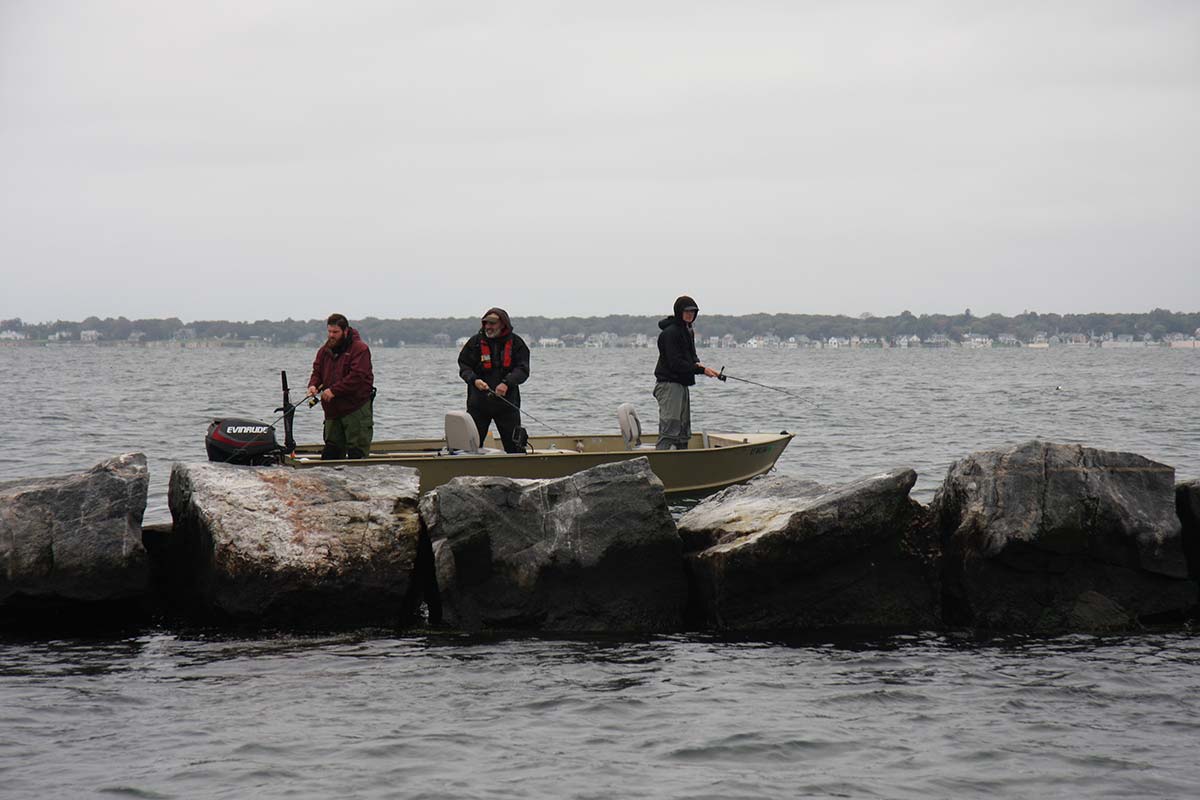
Why Shallow Water?
As a broad-but-accurate generalization regarding the autumn blackfish bite, tog favor foraging in depths of 20 feet or less, especially in the early season. Dedicated anglers should plan to target shallow-water hunting grounds for as long as mild water temps will allow. That means carefully locating and anchoring over shallow humps, rockpiles, and ledges. It could also mean anchoring as close as possible to rocky shorelines and breakwalls while still maintaining safety.
The reason shallows make sense is because skinny-water structures are closer to nourishing sunlight and therefore tend to carry the greatest density of the prey organisms blackfish prefer like barnacles and small shellfish. Another strong theory is that the invasive and numerous Asian crabs are prolific in shallower water, and they’re another favorite tog food.
Moving With The Season
“At this time of year,” says Capt. Kerry Douton, a blackfish expert and owner of the charter vessel Dot-E-Dee and J&B Tackle in Waterford, Connecticut (jbtackle.com), “the water temperature soon gets down into the high 50s, which makes blackfish migrate. In October, you’ll find them all in shallow water, and then they start moving as water temps fall.
“In the first two weeks in November it’s a mix—you can catch fish in some of the shallow water, but you can also catch them in deeper water as they move out. But from the second week of November on they’re only in deep water. The trick for success is to follow the fish out depending on the week and the water temperature. Many guys have fished them up until Christmas. You just have to be careful and pick your days.”
In early October we routinely pick large blackfish in only 12 to 15 feet of water, often on rock piles only a few hundred feet to a few hundred yards from shore. By mid-October, the fishing is red hot on almost every nearshore reef and breakwall along southern New England. But soon afterwards, many of those same reefs become devoid of keeper-size tog, and it’s not necessarily because they’ve moved out.
“Blackfish are so territorial that you can ‘fish a spot out’ very easily,” says Captain Douton. “They’re not like bluefish or bass. When they move in they stay in that area—that’s their home. Once they’ve been caught from a reef, a new group doesn’t just move in overnight. A lot of anglers don’t understand that. So when you get on a spot, drop your rig and don’t get any bites—unless you know it’s a bad tide condition—you have to move. It’s not like you can just stay there, and they’re going to suddenly come in.”
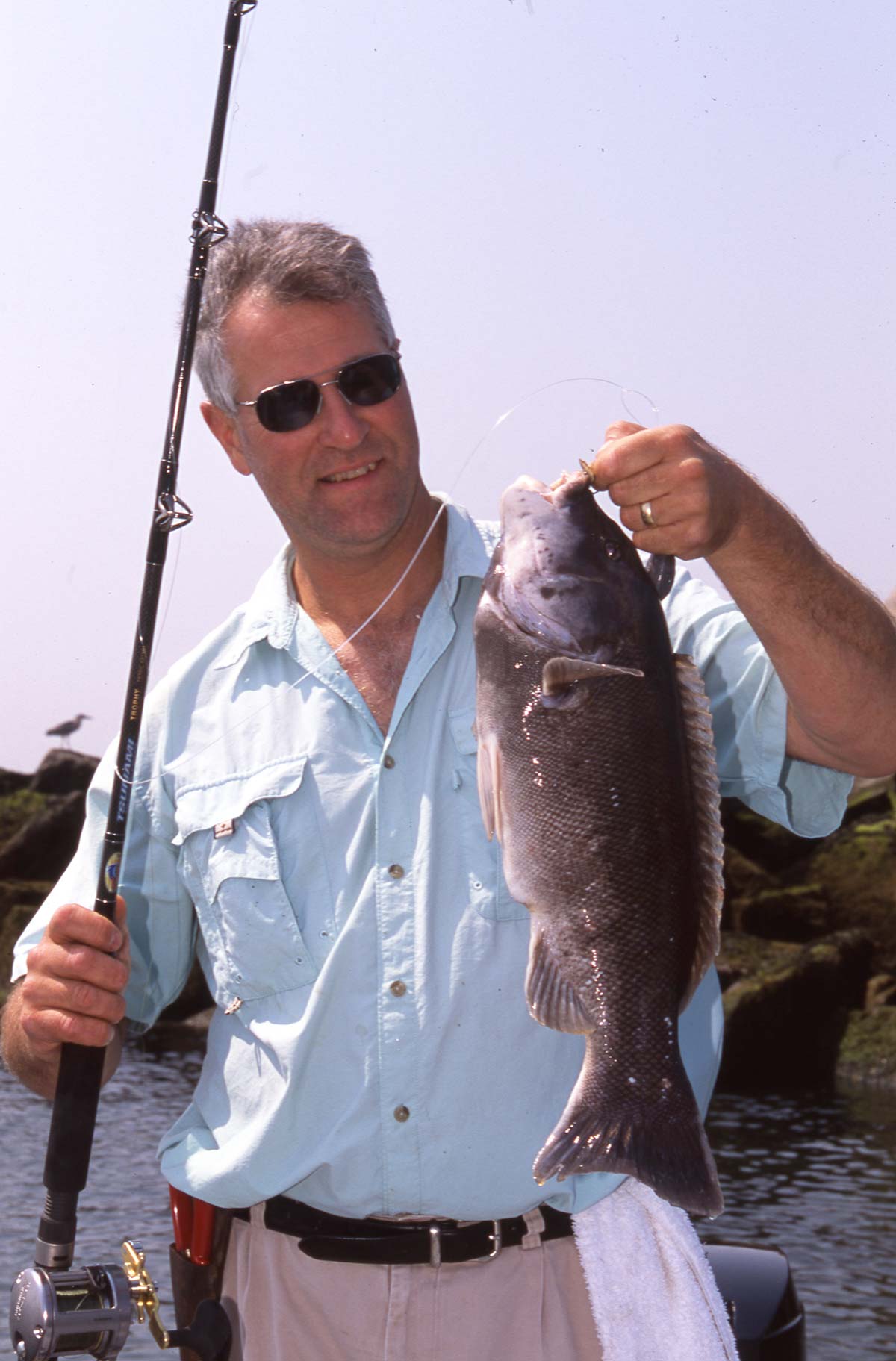
Movement Patterns
Aligning with Captain Douton’s statement, have you ever wondered why blackfish bite in certain areas at certain times but not at others? One week they seem to be jumping in the boat, while the next week it’s like dunking crabs in the Dead Sea. Understanding the habits of blackfish will help make the most of your time pursuing our favorite fall fish, rather than just guessing.
Looking back to earlier in the season, why don’t blackfish continue to bite well all summer like porgies, sea bass, and fluke? It’s because once the bottom water temperature breaks 68 degrees, blackfish leave their spring location or “homesite,” regardless of how abundant the food is, and move to deeper, cooler water for the summer. Tautog also have a poor tolerance for low dissolved oxygen and the lack of oxygen in the water might be just as much of a factor as temperature is regarding why the tautog move deep during the summer.
Many fishermen believe that blackfish are loners, but that’s not always the case. They do school prior to spawning, when preparing to migrate, and during migration to and from deep water—especially in the fall. Blackfish will also move from their homesite or home staging area when food sources disappear. We know that blackfish return in early fall as the water temperatures start to fall from late summer, but they leave the shallows again in November when bottom water temperature falls below that magic and key 50-degree mark, migrating into warmer water for the winter.
During non-spawning periods, blackfish prefer to hold along the crests and outer edges of coastal reefs. This tells us that you should drop anchor up-tide of the high point on a reef and drift back until you reach the peak, just like Vince and I did last October. That will be your best bet for finding tog, regardless of the season. Fishing during feeding periods is important, too.
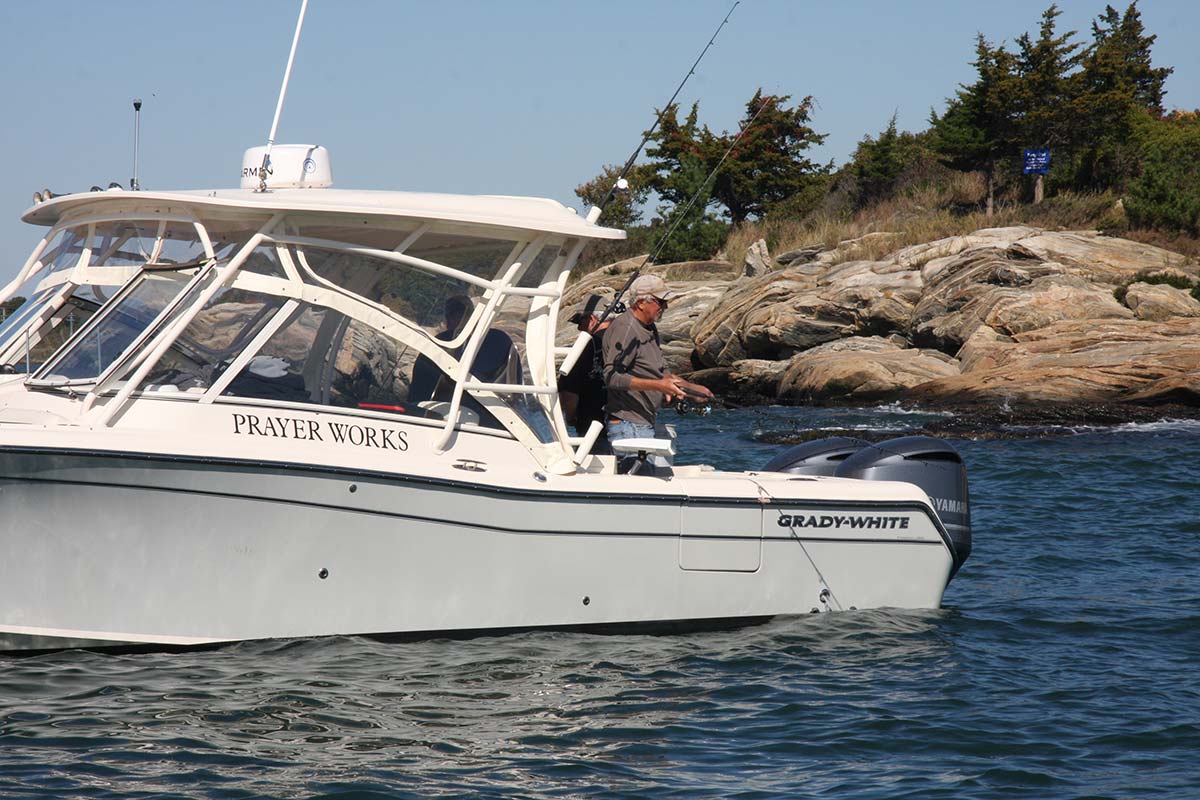
How They Feed
Blackfish forage throughout the day. According to studies and observations, they begin feeding shortly after sunrise, and they are extremely active for the first hour afterwards. But their activity decreases around mid-morning. Throughout the day they exhibit periods of rest after periods of feeding, which is linked with current flow.
When tog aren’t in eating mode, they stop their foraging behavior and rest in a sleep-like state in holes and crevices out of the current, often grouped, and sometimes even lying on their sides until a tide change stirs or “awakens” them. Peak activity occurs within about an hour of either side of the tide change—your best time to fish. Coincidentally, this is also when it’s easiest to hold structure with your bottom rig. However, another advantage of targeting tog in shallow water is the ability to maintain bottom contact with light weight—sometimes only 2 or 3 ounces is sufficient.
Blackfish use a “scan-and-pick” feeding pattern, which can lead them to wander up to 500 yards away from their homesite during the day when searching out food on contiguous structure. But they return to their adopted homesite for the night. This is how localized populations are formed. But that also means well-known or heavily-targeted hotspots get fished out first in the fall, leaving only the shorts, many of which have been caught multiple times over the weeks.
Blackfish also follow and feed in the intertidal zone (vertical area or “amplitude” between high and low tide points), especially during the flood tide. This allows them to forage on ledges, rocks, or pilings that are above the low-water mark. During the end of the ebb tide they ghost back out to deeper water. This implies that at high tide in the early fall season, you almost can’t fish in water that’s too shallow, with areas of only 10 to 15 feet deep sometimes producing the hottest action.
Feeding continues until sunset, but blackfish don’t feed after dark. According to studies, and contrary to what many anglers think, blackfish don’t have a superior sense of smell, instead they rely heavily on their keen eyesight to find food. This is why blackfish jigs can be so productive. This may also explain why they don’t feed at night. It may also answer why some tog sharpies succeed by chumming only with dry, broken-up, empty oyster or clam shells. It’s the sight that draws them to the boat, not necessarily just the scent.
| SHALLOW WATER SAFETY |
By nature, shallow water is riskier to fish in than deep water. Be mindful of changing conditions, use intelligent boating practices, and carry appropriate gear.
|
Which brings us to another point about seeking early-season blackfish in skinny water. Chumming is highly successful in the shallows because chum such as crushed mussels can sink into your target area and draw the fish to your hooks. In deep water with swift currents, however, most chumming efforts are wasted because the chum lands far down-current from your boat.
Vince and I boated and released about 25 fish that mid-October day last fall, carefully selecting the six 18-inchers we wanted to keep for the skillet. In fact, the action was so fast and steady that we both soon removed one of the two hooks from our rigs and just fished singles, which is one more reason to try the shallows—it’s quick and easy to reel up and rebait hooks in less than 20 feet of water.
So, take some lessons from marine biologists: explore different nearshore spots until you find one where tog are congregating and haven’t been fished out. Start shallow and move deeper as the season progresses. If blackfish aren’t feeding one week, don’t give up, they may be feeding there the next week. Use light-colored chum like live, smashed clams, which appeals to both their eyesight and sense of smell. Fish early in the morning, and don’t bother keeping your baits in the water during peak current or slack tide. When the current stops moving, blackfish take a nap—and so should you.


